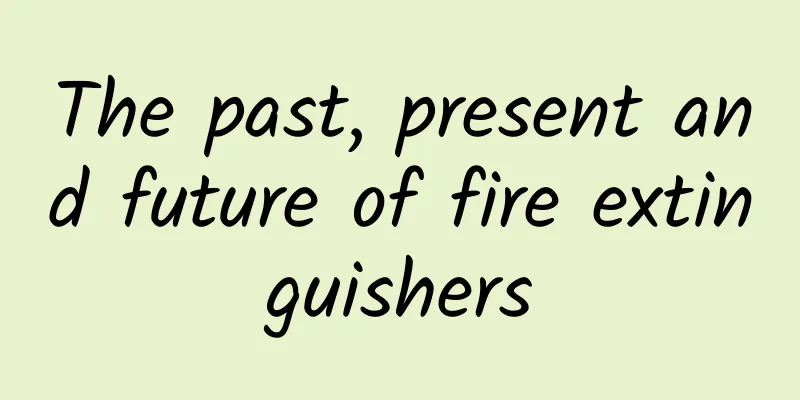The past, present and future of fire extinguishers

|
Fire extinguisher is the most important tool for human to put out the initial fire. Fire extinguisher has simple structure, easy to move and easy to operate. For two hundred years, people have used it to put out countless early fires, avoiding many casualties and property losses. Development History The history of fire extinguishers is not long. In 1816, British Captain Manby invented a portable fire extinguisher that uses compressed air to spray water. It is a cylindrical copper cylinder with a diameter of 20 cm and a length of 60 cm, with a capacity of 4 gallons. All current fire extinguishers in the world are derived from this invention. This invention made Manby, whose main job was not firefighting, famous in history. It was also the world's first water-type fire extinguisher. In the middle of the 19th century, French doctor Gallier invented a portable acid-base fire extinguisher, which contained a soda solution and a glass bottle with acidic liquid in the cylinder. When in use, the glass bottle is smashed to neutralize the two solutions and produce carbon dioxide gas. The pressure generated by the gas sprays the mixed liquid in the cylinder out and sprinkles on the burning object to extinguish the fire. In 1905, Professor Laurent of Russia invented a portable chemical foam fire extinguisher in St. Petersburg. The cylinder of this fire extinguisher is filled with a mixed solution of sodium bicarbonate and a foaming agent, and an inner liner is hung inside the cylinder, which is filled with an aqueous solution of aluminum sulfate. When in use, turn the fire extinguisher cylinder upside down to allow the sodium bicarbonate and aluminum sulfate solutions to mix and undergo a chemical reaction to produce carbon dioxide gas, causing the foam volume to expand 7-10 times and spray out to extinguish the fire. Then people invented the air foam fire extinguisher (called mechanical foam fire extinguisher at that time). It has excellent performance, long shelf life, high fire extinguishing efficiency, convenient and safe use, and is an upgraded product of chemical foam fire extinguisher. In order to deal with Class C (gas) fires and Class E (electrical) fires, developed countries invented carbon dioxide fire extinguishers in the early 20th century. The biggest feature of this fire extinguisher is that it leaves no trace after extinguishing the fire. However, carbon dioxide fire extinguishing has poor resistance to re-ignition and is not suitable for extinguishing solid organic fires. Therefore, people have tried hard to develop more effective gaseous fire extinguishing agents for fire extinguishers. Halons are of interest. Halons are hydrocarbons in which one or more hydrogen atoms have been replaced by halogens (fluorine, chlorine, bromine or iodine). This substitution not only makes the halons non-flammable, but also gives them fire-extinguishing properties. Such extinguishing agents can be used in portable fire extinguishers. In this field, people first invented the carbon tetrachloride fire extinguisher. In 1909, Davidson of New York, USA, obtained a patent for the carbon tetrachloride fire extinguisher. This fire extinguisher uses carbon dioxide to press carbon tetrachloride out of the fire extinguisher to suffocate the flame. Due to the strong toxicity of carbon tetrachloride, this fire extinguisher was eliminated first. In 1947, relevant US departments conducted a systematic evaluation of more than 60 types of halons that had been successfully developed based on their fire extinguishing performance and toxic effects. Among them, halons 1211 and 1301 were relatively ideal. Therefore, these two fire extinguishing agents were widely used for fire fighting, including in fire extinguishers. Dry powder fire extinguisher is another type of fire extinguisher developed by humans in the 20th century. At first, it uses the driving pressure in the gas cylinder to spray the fine dry powder fire extinguishing agent that is easy to flow from the fire extinguisher cylinder and shoot it towards the flame in the form of powder, mainly extinguishing the fire through chemical inhibition, so the fire extinguishing efficiency is very high. People discovered that sodium bicarbonate could extinguish fires as early as the 19th century, but it was not until 1928 that the gas cylinder dry powder fire extinguisher was developed. In 1943, people developed an improved, finer-grained sodium bicarbonate dry powder. By 1947, the United States adopted this dry powder fire extinguisher. As the use of flammable liquids increased, people began to develop dry powder fire extinguishing agents with higher fire extinguishing efficiency. In 1959, a dry powder fire extinguishing agent based on potassium bicarbonate was introduced, which was obviously more effective than sodium bicarbonate fire extinguishing agent. In 1961, the United States developed a "multi-functional dry powder", namely ABC dry powder. This dry powder fire extinguishing agent is not only more effective than sodium bicarbonate dry powder and potassium bicarbonate dry powder in extinguishing flammable liquid and electrical fires, but can also be used to extinguish Class A fires. At first, people used relatively low-priced diammonium hydrogen phosphate as the base material of dry powder fire extinguishing agent. Later, more people used monoammonium phosphate (or diammonium phosphate) with better moisture absorption resistance as the base material of dry powder fire extinguishing agent. The above dry powder fire extinguishing agents are all used in fire extinguishers. my country began to develop dry powder fire extinguishing agents in the 1960s, and has successfully developed sodium bicarbonate fire extinguishing agents and modified sodium salt dry powder fire extinguishing agents. In 1982, the Shanghai Fire Research Institute of the Ministry of Public Security successfully developed the ABC dry powder fire extinguishing agent with diammonium dihydrogen phosphate and ammonium sulfate as the mixed base. After it was put into production, ABC dry powder fire extinguishers appeared on the market, gradually breaking the original situation of many competitors in the country. ABC dry powder fire extinguishing agent has been widely used due to its high fire extinguishing efficiency, ability to extinguish a wide variety of fires, fast fire extinguishing speed, ability to be used in low temperature environments, excellent electrical insulation properties, ease of use, long storage period and low price. To date, the vast majority of fire extinguishers installed in public places in my country are still ABC dry powder fire extinguishers. Survival of the fittest In the past two decades, the fire extinguisher landscape at home and abroad has undergone great changes. Acid and alkali fire extinguishers and chemical foam fire extinguishers have been eliminated mainly because they are not safe enough to use. They must be used upside down, which could result in injury to the operator. Halon fire extinguishing agents have been phased out in many developed countries since the mid-1990s because they damage the atmospheric ozone layer and endanger human health and life. my country also cut the production of 1211 and 1301 fire extinguishing agents to zero in 2005 and 2010 respectively. On the contrary, water-based fire extinguishers have been greatly improved compared to similar products of the year, achieving improved fire extinguishing efficiency, strong anti-reignition ability, and multifunctionality. Today's water-based fire extinguishers are not only suitable for extinguishing Class A fires, but also for extinguishing initial fires of flammable liquids. Anti-soluble water-based fire extinguishers are also capable of extinguishing fires of water-soluble liquid fuels such as methanol, ether, and acetone, and are suitable for gas stations, garages, and laboratories. Water-based fire extinguishers equipped with special spray nozzles are also suitable for extinguishing initial fires of live equipment. They are becoming more and more popular in the market. The combination of water-based fire extinguishers and dry powder fire extinguishers can also improve fire extinguishing efficiency, which can largely make up for the poor anti-reignition performance of dry powder fire extinguishers when fighting oil fires. Places such as high-speed rail carriages have taken the lead in implementing a mixed configuration of water-based fire extinguishers and ABC dry powder fire extinguishers. Compared with the rapid technological progress of water-based fire extinguishers, ABC dry powder fire extinguishers have not made much technological progress in the past two decades and have not solved some of their inherent problems. shortcoming: If dry powder is used to extinguish a fire, it will cause secondary pollution. The dry powder mist will irritate the human respiratory tract and even have a strong suffocating effect. The diffuse powder mist will hinder people from finding a safe exit. Changes in products on the market have led to corresponding revisions to the national standard. In GB4351-1997 "General Technical Requirements for Portable Fire Extinguishers", portable fire extinguishers are divided into five categories according to the extinguishing agent they are filled with, namely water-type fire extinguishers, foam-type fire extinguishers, dry powder-type fire extinguishers, halogenated fire extinguishers and carbon dioxide-type fire extinguishers. In the 2005 edition of this standard, portable fire extinguishers are divided into four categories according to the extinguishing agent filled, namely water-based, dry powder, carbon dioxide and clean gas, which is consistent with the international standard classification. The water-based fire extinguisher is described in brackets. The water type includes clean water or water with additives, such as wetting agents, thickeners, flame retardants or foaming agents. This means that fire extinguishing agents such as clean water and water-based fire extinguishing agents with added wetting agents, thickeners, etc., as well as the original foam agent fire extinguishing agents all become secondary classifications under water-based fire extinguishers with water as the base material. Foam fire extinguishers no longer have the first-class classification status in the 1997 edition of GB4351.1. At the same time, halogenated fire extinguishers also had their first-class classification status cancelled and were replaced by clean gas fire extinguishers. In many fire science popularization materials and books, readers are still introduced to the classification according to the 1997 edition, which needs to be corrected. Looking ahead Looking ahead, we can see several trends. Water-based fire extinguishers continue to improve in technology, their fire extinguishing efficiency is getting higher and higher, and their market share is gradually increasing. The number of dry powder fire extinguishers will decrease accordingly. However, since ABC dry powder fire extinguishers still have advantages in price, long effective service life and high fire extinguishing efficiency for a considerable period of time in the future, they will continue to play a role. In more occasions, they will be mixed with water-based fire extinguishers to complement each other's advantages. People will develop ideal substitutes for halogenated fire extinguishers to make up for the shortage of clean gas fire extinguishers left after halogenated fire extinguishers are eliminated. Of course, essential work in the future also includes daily maintenance of fire extinguishers and training the public on how to use them. No matter how advanced the technology of fire extinguishers is and how properly configured they are, if they are not in good condition or people nearby do not know how to use them correctly, they will not be able to play their due role in extinguishing an initial fire. END Text | Fan Qiangqiang Picture | From Baidu Pictures |
>>: “Cats are treacherous, dogs are loyal”, are cats really heartless?
Recommend
In the future, can electric cars replace gasoline cars?
With the development of society and the advanceme...
iOS 12 verification code autofill is convenient, but is it secure?
One of the new features of iOS 12, which will be ...
The reverse logic of Xiaohongshu’s advertising under the “high pressure crackdown”
Xiaohongshu has undergone a lot of changes during...
Jinan Mini Program Franchise Company, how much does it cost to join a points mini program?
How much does it cost to join the Jinan Points Mi...
Now that Japan’s “National EV Alliance” has been formed, can Chinese car companies use fewer tricks between them?
If you want to know what best reflects the confid...
20 tips for hot-selling headlines!
Besides the content, the most important thing abo...
How to build muscle? Liu Mengyi's "Seven Major Muscle Group Sculpting Training" World Champion teaches you how to train muscles
Training course video lecture content introductio...
5 tips for running promotional events!
Usually when it comes to operational activities, ...
Alipay's practical Spring Festival functions: write blessing characters, check epidemic situation, and watch New Year short films
The Spring Festival is approaching, but the origi...
Umeng Open Day: App push strategy from the perspective of content operation and statistical analysis
Nowadays, message push is no longer just a quick ...
Several ways to make money on Douyin. What are the ways to make money on Douyin?
The largest traffic is in the Internet industry, ...
Apple reveals top 10 reasons why apps are rejected from the App Store
Apple has released a new webpage featuring the to...
Pessimism and caution spread: small and medium-sized mobile game teams will make their last stand
Nowadays, "recruitment is much better than b...
Google announces Android Jetpack Compose is now available in Beta
Google has just announced through the Android Dev...









